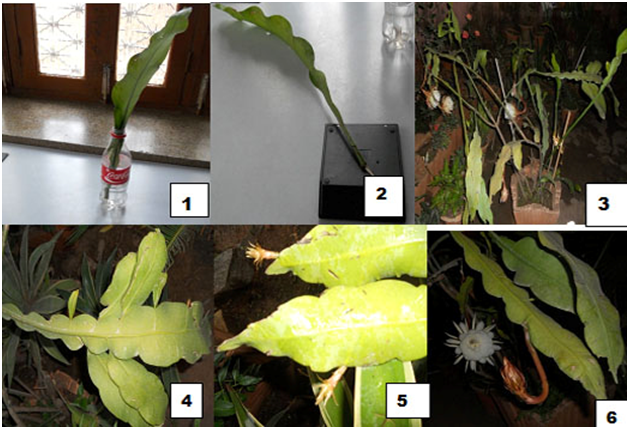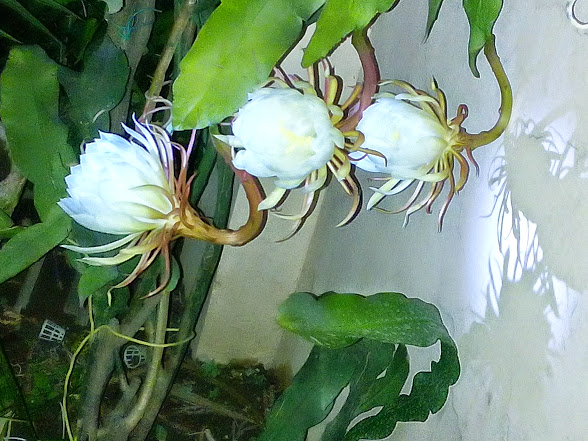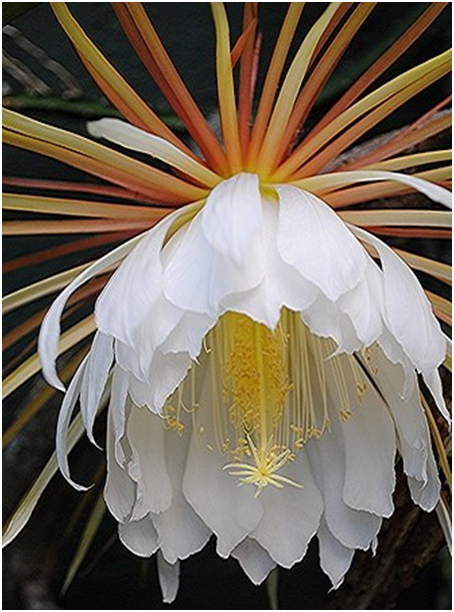EPIPHYLLUM OXYPETALLUM (BRAHMAKAMAL) - ORCHID CACTUS STAR OF - BETHELIEUM
Epiphyllum oxypetalum is a very interesting and unique plant. It belongs to Family Cactaceae. It is commonly known as Night blooming Cereus, Queen of the night, Lady of the night as its beautiful Lotus like flower blooms late night.. It is popularly known as Orchid Cactus as the flower has orchid like beauty and plant resembles cactus in habit. It is known by different common names in different parts of the world viz. Jungle cactus, Dutchman's Pipe
Interestingly, many people in India don’t make a fine botanical distinction between Saussurea Obvallata and Epiphyllum Oxypetalum (A night blooming cereus – family cactaceae) and also treat Epiphyllum Oxypetalum as Brahm Kamal. This flower is also known as ‘Star of Bethelieum’, and ‘Dutchman’s pipe’ or Queen of Night and belongs to the species of Succulents. These are grown in the planes of India viz. Maharastra and Kerala etc and Sri Lanka. The petals look like lotus but are of smaller size. This is a night bloomer with lovely fragrance and the flower lasts as only for one night and is supposed to bloom only once a year.
Nomenclature
Botanical name : Epiphyllum oxypetalum (DC.) Haworth The generic name Epiphyllum of the plant refers to flowers borne on leaf like phylloclade and the Specific name oxypetalum refers to acute petals
Epiphyllum oxypetalum plant is native to Sri lanka where it is known as Kaduphul ,it is believed that plant blooms rarely and that too late night. In India this plant has been reported from different parts like Mumbai, Bangalore,Chennai, Ranchi ,Uttrakhand etc. The plant flowers generally in rainy season from mid June to mid October.
It has diverse distribution and grows wild in tropical rain forests. Epiphyllums are indeed true cacti, but are more often labeled as "Epicacti" or "jungle cacti" to differentiate them from related desert flora. A slightly different type is found in Mexico, Brazil, Venezuela and is locally described as Phyllocactus purpusii . It is also found as a cultivated plant in some parts of America such as California either as Epiphyte or Lithophyte. Here the flowers bear carmine red coloured outer tepals and instead of sweet fragrance has slightly unpleasant smell.
Cultivation and propagation Propagation
To grow the plant a matured leaf of an existing plant is planted in the soil. The plant has almost no stem, the base of the leaf which is planted becomes hard and transforms into a small stem. The flower blooms from the sides of the leaves. The plant grows to a height of 1 - 1.5 mtr. but the flowers themselves are 1.5 to 2 cm.
It prefers acidic soil and filtered sun light. It can also be grown indoor .To grow the plant , a Phyllocade is planted in the soil or is placed horizontally on soil. The cut phylloclade can also be dipped in water (Figure 1) . In about three weeks adventitious roots come out , then can be planted in pot containing soil. From margins of phylloclade bulbil like structures grow ( Figure-3).

Figure: 1-Cut phylloclade dipped in water 2- Adventitious roots coming out from cut end 3- MatureEpiphyllum oxypetalum plant in a pot 4- Phylloclade 5- Young flower bud emerging from serrate margin of phylloclade 6- Bud with peduncle and a bloomed flower.
Very easy to grow in milder areas, moved mine from Chandigarh to Ludhiana and now in Dehra Dun . It is sensitive to extreme cold here so I moved it under a tree where it gets filtered light and cut back on the water for the winter. I have had the same plant for over 20 years. Some leaf sections were given to me and I was told to "damage" the ends of the leaves to help them establish roots. So I took the poor innocent leaves and whacked the ends of them and stuck them in a pot filled with regular potting soil. It took off and bloomed the following fall. Beautiful blooms! Love this carefree and beautiful plant
Brief Morphological Description Stems are branched and erect, climbing or sprawling, profusely branched, primary stem cylindrical, 1-4 m long, flattened laterally. Secondary stems (which look like leaves) are flat, elliptical , acuminate, about 30 cm x 12 cm in size, with wavy and crenate margins (Figure- 3 ).
Flowers are produced from flattened portion having brownish receptacle 13 to 30 cm long . Flowers are 12-17 cm wide ( Figure -4,5 & 6 ) bearing green slightly angled short narrow about 10 mm long arching bracteoles , outer tepals linear, acute, 8–10 cm long reddish to amber; inner tepals oblanceolate to oblong, acuminate, to 8–10 cm long and 2,5 cm wide, whitish; stamens many (about 100) white, filament delicate slender and weak; style greenish white or white, 4 mm thick, as long as inner tepals, when flower bloms, later on become longer and comes out of tepals ends ends pale yellow or white multilobed stigma. Round pollen grains are with thick exine). Fruit is oblong, 12 x 8 cm, purplish red, angled. The flower is nocturnal with fragrance dispering in its surroundings .The principal odour component in the aroma is of benzyle salisylate.
Blooming of Flower Orchid cactus flower starts blooming after sunset from 7 p m onwards and takes about two hours to full bloom,about 8 inches in diameter and remain open through out night. It closes in the morning before sunrise appear drooping on long stalks.Since the flowers are predominantly pollinated by bats and large moths. They have large pure white star-like flowers with lovely fragrance to help their pollinators locate the blossoms by moon or star light.
This flower, named after Brahma, the God of Creation (as per Hindu mythology), blooms only for one night in the entire year, somewhere between mid June and mid October. The blooming lasts only for a few hours. Brahmakamal is related with the story of how Brahma emerged from Vishnu’s naval in a lotus flower. It ia also believed that it is a sacred flower and does not bloom in all homes and in the homes where it blooms are considered lucky and is a sign or notation of prosperity. There are some interesting stories about the Brahmakamal. It is believed that it is the flower in which Hindu God Brahma resides and the place where it blooms will be the receiver of glad things. People who pray to God while the flower is blooming get their wishes fulfilled. There is a belief that the Brahmakamal should be gifted and should not be sold or bought from the market .
Medicinal uses
The phyllocaldes contain some active ingredients and show antibacterial activity.The stem is also used medicinally to cure dropsy and cardiac affections.Vietnamese people use petals of the faded blooms to make soups which are supposed to have tonic and aphrodisiac medicinal properties.
Confusion about the Brahma Kamal flower
Some from northern part of India claims that the flower of Saussurea obvallata of family Compositae to be Brmaha Kamal. Which is a very beautiful flower of valleys in Himalayan ranges. However there are people who claim that flower of Epiphyllum oxypetalum(Orchid Cactus), which blooms at night, to be Brahma kamal.

ABOUT 7 AM IN THE MORNING

9 PM BUDS ARE ABOUT TO BLOOM

11 PM THE FLOWER HAS BLOOMED

FULL BLOOM TOP VIEW

FULL BLOOW VIEWFROM THE FRONT (JUSEUS IN THE MANGER)